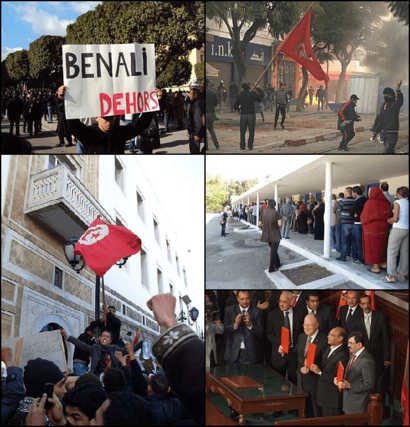Tunisian revolution facts for kids
Quick facts for kids Tunisian revolution |
|
|---|---|
| الثورة التونسية (Arabic) Part of the Arab Spring |
|
 |
|
| Date | 17 December 2010 – 14 January 2011 (4 weeks) |
| Location | |
| Caused by |
|
| Methods |
|
| Resulted in |
|
| Casualties | |
| Death(s) | 338 |
| Injuries | 2,147 |
The Tunisian Revolution (Arabic: الثورة التونسية) was a big protest movement in Tunisia. It lasted for 28 days, from December 2010 to January 2011. People took to the streets to protest against their government. This led to the leader, Zine El Abidine Ben Ali, leaving power. He had been in charge for 23 years.
The protests helped Tunisia become a more democratic country. This means people got to vote in free elections. Many people see the Tunisian Revolution as the only successful movement of the Arab Spring. The Arab Spring was a series of protests across many Arab countries.
People protested for many reasons. There were not enough jobs, and food prices were too high. There was also a lot of corruption, which means dishonest actions by those in power. People also wanted more political freedoms. They were tired of poor living conditions. These protests were the biggest in Tunisia in 30 years. Many people were hurt or died, mostly because of actions by the police.
The protests started after a young man named Mohamed Bouazizi died on December 17, 2010. His death sparked anger across the country. Ben Ali left Tunisia on January 14, 2011, and went to Saudi Arabia. This ended his long rule.
Workers' groups, called labor unions, were very important in these protests. A group called the Tunisian National Dialogue Quartet later won the 2015 Nobel Peace Prize. They won it for helping Tunisia become a peaceful democracy after the revolution. The events in Tunisia also inspired similar protests in other Arab countries. This chain reaction became known as the Arab Spring.
What the Revolution is Called
In Tunisia and other Arab countries, this event is simply called the revolution. Sometimes, it is called the Sidi Bouzid revolt. This name comes from Sidi Bouzid, the city where the first protests began.
In Western countries, it is often called the Jasmine Revolution or Jasmine Spring. This name comes from Tunisia's national flower. It also fits with how other big political changes are sometimes named, like "color revolutions." An American journalist named Andy Carvin first used the name "Jasmine Revolution." However, people in Tunisia did not widely use this name themselves.
The name people in Tunisia chose was the Dignity Revolution. This is a translation of the Arabic name for the revolution, ثورة الكرامة (Thawrat al-Karāmah).
Some people have also called it the WikiLeaks revolution or the Facebook revolution. This is because social media was a main way for people to share information during the protests. Also, articles from WikiLeaks helped fuel anti-government feelings.
Images for kids
-
Tunisian soldiers serving as gendarmes
-
Nantes, France, demonstration in support of the Tunisian protests
See also
- 2008 Tunisian protests
- 2011-2012 Tunisian protests
- Art and politics in post-2011 Tunisia
- List of conflicts in Africa
- List of modern conflicts in North Africa
- Operation Tunisia






